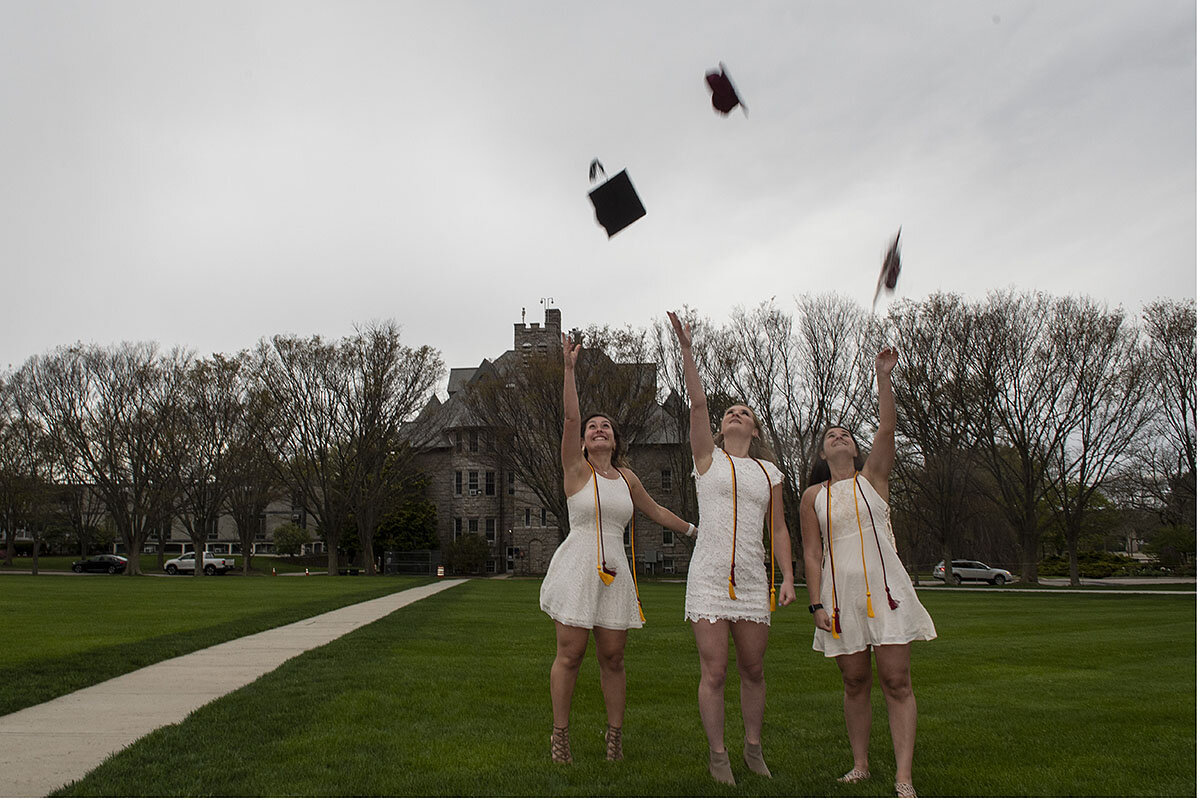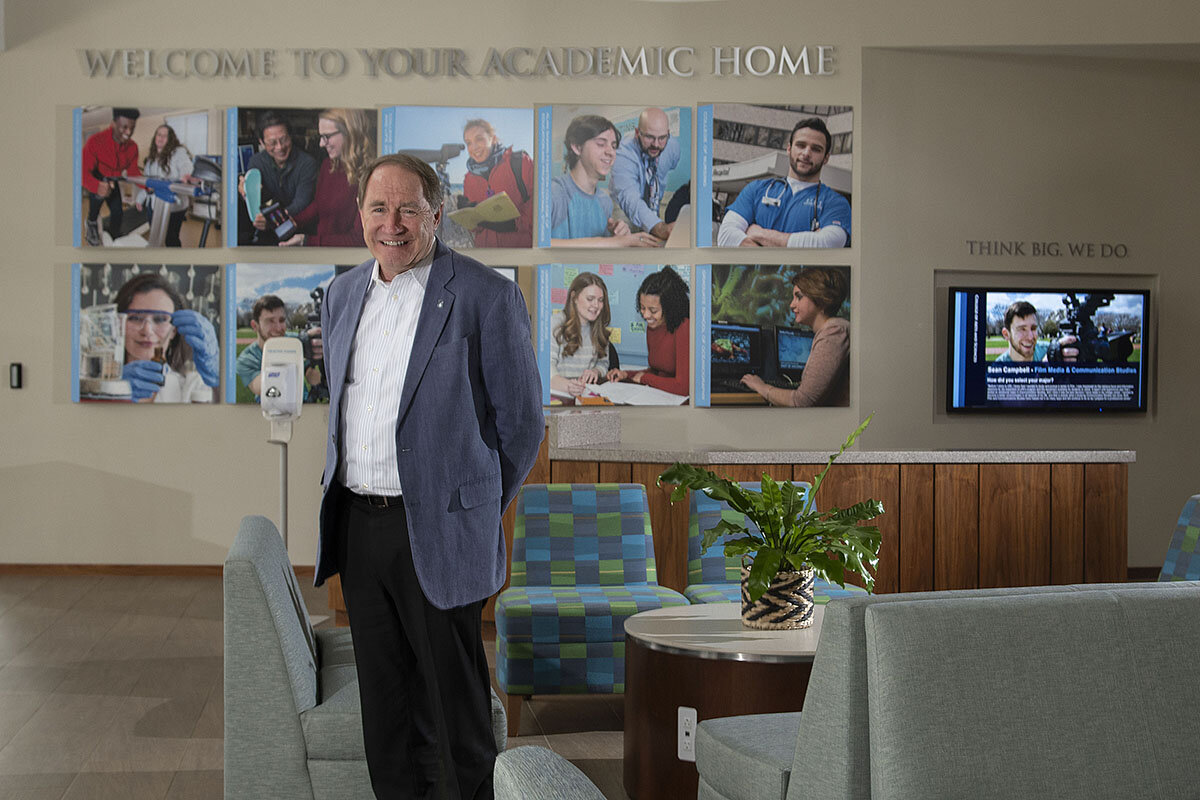Stay-at-home college? Campuses focus on finances, and survival.
Loading...
| Kingston, Rhode Island
In any other year, the University of Rhode Island in Kingston would be bustling. Now, due to the pandemic lockdown, it’s deserted. Students are at home; classes are online; buildings are closed.
A security guard on a bicycle makes sure even the new welcome center is shut tight by rattling its locked doors loudly. Uncertainty hangs heavily in the spring air.
“Any institution that is saying with any degree of confidence what the fall is going to be like, honestly, I think they’re whistling in the dark,” says David Dooley, the university’s president, sitting inside the welcome center in early May wearing a face mask. About the only sure thing is that URI – which in recent years has faced head-on the problems of running a viable university system – will be in the red. “We are anticipating that we will take a significant financial hit,” he says.
Why We Wrote This
How might the college experience change post-lockdown? Many schools had already been addressing financial issues, but the coronavirus is hastening decisions around delivery of classes and whether to stay open.
Editor’s note: As a public service, all our coronavirus coverage is free. No paywall.
It’s a reality for America’s more than 4,000 colleges and universities. Already under stress from declining government support and rising skepticism about the value of a college degree before the pandemic, these schools now face a perfect storm of economic downturn: less state support, financially needier students, and quite possibly a shrinking freshman class. So far in 2020, eight colleges and universities are merging with others or closing, including Holy Family College in Manitowoc, Wisconsin, and 174-year-old MacMurray College in Jacksonville, Illinois, both citing the pandemic as a complicating factor. Dozens more are expected to close in the next few years.
But the economic challenge that’s forcing difficult cuts on college campuses has also unleashed in places a furious bout of innovation as colleges and universities rethink higher education and its delivery to students in the 21st century.
“We are ready to change,” says Lynn Pasquerella, president of the Association of American Colleges & Universities. “I am confident the system will come out stronger.”
Financial balancing act
The pandemic-led lockdowns have already cost schools billions of dollars. To hold on to students for the fall, particularly those whose parents are suddenly unemployed, colleges and universities will have to hand out more financial aid. Unemployment will shrink the tax base for states, which in turn will have to cut support for state schools. Given all that, institutions are proving very reluctant to reduce tuition for the 2020-21 academic year.
“What I’m hearing is a hard ‘no’ on that front,” says Kevin Walker, founder and CEO of CollegeFinance.com, a website for students and parents.
One of the big uncertainties is whether states will allow campuses to open this fall and, if so, how many students will attend. Travel restrictions are likely to limit the number of international students coming to the United States. A survey of nearly 1,200 American high school seniors in late April found that 12% who had already made deposits no longer planned to attend a four-year college full time, according to consulting firm Art & Science Group. And two-thirds said they expected to spend “much less” tuition if colleges went all-digital in the fall. Already, some students are suing schools to get tuition refunds for the spring because the all-digital classroom didn’t measure up.
But schools may get some help on that front. The same travel restrictions and economic hardships that might keep students from attending school also limit their alternatives, such as getting a job or deferring enrollment.
Lily Nguyen, a high school senior in Waltham, Massachusetts, had planned to take a gap year if her school of choice, the University of Massachusetts Boston, went all-digital for the fall. But foreign travel restrictions put an end to her plans to volunteer in Spain or South Korea. Even if UMass Boston is just online, “I think I will still be attending classes,” she says.
A time to innovate
In spite of the cuts, and sometimes because of them, schools are innovating to make themselves more attractive to students.
Some colleges and universities, which this spring had a crash course in online teaching, are hard at work trying to improve the digital experience. Last week, the nation’s largest four-year public university system – California State University – announced it would this fall.
Southern New Hampshire University (SNHU), a leader in online education for adults already in the workforce, has a third of its faculty working this summer to reimagine its curriculum for its 3,000 on-campus undergraduates. The goal is to bring tuition down for these students from $31,000 a year to a breathtaking $10,000 in order to make higher ed more widely available to people who can’t afford it. The plan, hatched last October, was supposed to be phased in over three years starting in 2023. But the pandemic-led downturn has pulled forward the timing to begin the transition in 2021.
To attract freshmen for this year, the school in Manchester is offering free tuition to everyone willing to spend one year with the current curriculum before moving to the revamped courses the following years. To bring tuition down, SNHU is considering, among other things, doubling the number of on-campus students; melding online instruction, some of it prerecorded, with face-to-face interaction with full-time faculty; and emphasizing experiential learning. For example, instead of engineering classes, the faculty might assign teams of students to work on a real-world project for a company and monitor their mastery of skills.
And the key to attracting students to a more digital model might not lie in the delivery of academics but in the social supports that surround them, says the university’s president Paul LeBlanc. “For our adult learners, our secret sauce is … the way we deploy advising,” he says.
For years, advisers have been working closely with the school’s 135,000 online students, checking in, encouraging, and sometimes becoming confidants about problems at work or with family, he says. The school is now having to think through how to deliver more online supports for traditional undergraduates, who will probably have more of their curriculum delivered online. That means rethinking the mundane, like offering computer help at 2 a.m., as well as the more difficult emotional areas of connectedness and motivation.
Attending college represents academic advancement, but it also involves coming-of-age experiences from friendships to clubs and sports to parties, Dr. LeBlanc says. “When [students] say, ‘I don’t want to do online,’ part of it is they’re grieving the loss of this” social side. If the school is to succeed with these students with far less face time, “they need to know someone cares that they’re doing their work.”
Miami Dade College in Florida – one of the nation’s largest colleges, with a student population that is 70% Hispanic and 44% below the poverty line – is gearing up for a surge in enrollment, which typically happens during economic downturns. Since announcing it would hold all its summer courses online, students are rapidly signing up. One of its new offerings is pandemic-inspired. “We are in the process of developing a contact-tracing curriculum that we hope to launch in the next couple of weeks,” says Lenore Rodicio, the school’s executive vice president and provost.
Fast-tracking tech vision
Further north, at the University of Rhode Island, Dr. Dooley is toying with the idea of a major based on managing pandemics. He says the crisis has accelerated the university’s move to a 24/7 learning environment supported by technology, where, for example, students might take in a professor’s lecture at their convenience – 7 p.m. or even 3 a.m. – rather than in class at a specified hour.
“We have more faculty than ever who are interested in learning how to do that,” he says. “That enables students to progress to their degree in a time frame that they have a lot of control over – and that isn’t just all tied up in what we recognize is a rather arbitrary 15th century academic calendar.”
URI has experience with surviving tough times. When he arrived on campus as president in 2009 – in the depths of the Great Recession – Dr. Dooley set the faculty to work on revising its general curriculum and doubled down on an initiative already in place: a laser focus on student achievement. One innovation was that courses were revamped so that any general education class counted toward the requirements of any major, so a student in political science could transfer to engineering without wasting any credits.
The results: Undergraduate enrollment is up from under 11,000 to about 14,600 today. Average time to graduate has declined from more than five years to 4.2. Support from the state legislature has moved from $58 million to about $84 million. The pandemic will likely change that, but Dr. Dooley says the goal is the same: focusing on student success.
“We simply could no longer afford the notion, which public institutions had long operated under, that we’re here, you can come and you sink or swim,” he says. “Instead, the notion needs to be: If you choose to come to us, our mission is to do everything we can to help you succeed.”
Editor’s note: As a public service, all our coronavirus coverage is free. No paywall.






